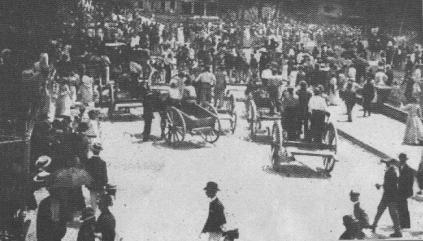

|
Revolt

What looks like downtown Port of Spain on a busy shopping Saturday,
is really the prelude to the Water Riots in 1903, which ended
in many peopledead and wounded and the Red House gutted by fire.
From the time of Governor Sir Thomas Picton, slave insurrection, public display of decapitated heads, public whippings (1,500 lashes for desertion) from the army was meted out to both free and enslaved, military and civilian, even to young girls, on through to slaves prisoners on the estates.
This happened in a period from 1797-1805; then the Port Of Spain Riots of 1849 took place, when a British regiment opened fire on a mob intent on destroying the Government building (later the Red House) in protest of a law stating that the heads of debtors be shaved in the same manner as convicted felons. The law was repealed. In the 1890s,the Canboulay Riots and the Hosay Riots took place. This was followed 13 years later by the famous Water Riots, when a mele ensued. The Red House was burnt down and 16 people were shot.
Just 34 years later, the country experienced a general strike in which riots swept the city and protesting workers were shot out of hand at various places around the country. In 1970, Port of Spain's Woodford Square again saw demonstrations, riots and shootings. The events of 1990 are well known. This re-occuring cycle of official reaction has now become virtually inherited, involving basically the same people for close to 200 years.
In the context of these articles appearing in this issue of the Historical Digest', we will deal with events that led up the Water Riots of 1903.
Crown colony rule was frustrating for the general populace right across the board. It was repressive to the lower classes, mostly black people, and it tended to debar upward mobility confining the children of the ex-slaves to perpetual poverty. It was humiliating to the colour people and the white middle class, who, notwithstanding the heroic attempts at educating their children and mind boggling and convoluted endeavours to achieve and maintain European cultural patterns and a respectable lifestyle, were still outside the pale and likely to remain there.
The upper class French Creoles were jealous of the English for their positions and smarting at the slights dished out by the people whom they considered to be beneath their social standing. They were the grandchildren of the original, aristocratic colonists who had, after all, come here first. The Indians were completely out of the equation socially and politically at this point.
In the closing years if the 19th century, opposition to colonial rule became more general and in fact more radical. What was mostly a middle class dissatis-faction evolved into movements that attracted working class support.
Joseph Chamberlain, the Secretary of State for the Colonials, the Governor's boss, bushed aside the reform movements and turned down appeals for any form of elected representation in the Legislature, summing it up thus "Local government (falsely so called) is the curse of the West Indies. In many islands it means only local oligarchy of whites and half-breeds always incapable and frequently corrupt. In other cases it is the rule of the Negroes, totally unfit for representative institutions and the dupes of unscrupulous adventures". He followed this up by ending the token majority of local unofficials in the Legislative Council nominated by the Governor.
He then moved on the Port of Spain Borough Council. An elected body set up in 1853,it had served as an important forum for local politicians, particularly the black and coloured radicals, and was the only voice through which any national view could be expressed by elected representatives. The conditions placed on the members were tough and they voted not to accept these and, in effect, voted themselves out of existence. Chamberlian ordered a Board of Commissions put in place to the city. It was felt that this amount to "the killing of a school to teach people to manage their own affairs".
These were not significant issues, however, to attract mass support. The young but vigorous Trinidadian Workingman's Association was much better able to do rally people around their causes, and so too was the Pan African Association led by a London-base lawyer called H.S. Williams. The next and significant link was forged by the creation of the Rate Payers 'Association, comprised mostly of professionals and businessmen. This group of taxpayers sought to act as a counter balance against arbitary measures, taken by the government, particularly in the distribution of water in the city. These groups acted, more or less, in an organised manner. The grassroots, however alienated, poor and easily manipulated, were moved by the rhetoric of Rate Payers 'Association's principle speakers, Emmanuel Lazare, Maresse-Smith and others. Those speakers urged them to assemble in Woodford Square, outside the Red House, on the day when the new Ratepayers Ordinance was supposed to be read. The purpose was to prevent this reading. The Ratepayers' Association's radicals made a strenuous effort to excite the assembled crowds against the government. The outcome was a major riot during which the old Red House was completely burnt down. Much of recorded history was forever lost in this fire. Soldiers were called in, and 42 people were wounded, 16 lost their lives. THE END
• Emancipation: After the 1834 proclamation
Trinicenter.com | TriniView.com
Any problems with this page? Contact our webmaster.
Education 2000@ TriniView.com
|
